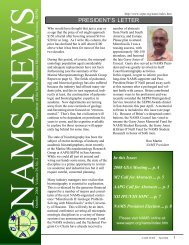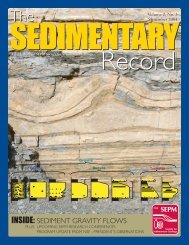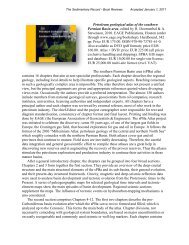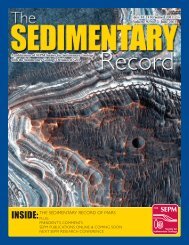PDF of contents and abstracts - SEPM
PDF of contents and abstracts - SEPM
PDF of contents and abstracts - SEPM
You also want an ePaper? Increase the reach of your titles
YUMPU automatically turns print PDFs into web optimized ePapers that Google loves.
USING PALEOSOLS TO UNDERSTAND PALEO-CARBON BURIAL<br />
NATHAN D. SHELDON<br />
Department <strong>of</strong> Earth <strong>and</strong> Environmental Sciences, 1100 N. University Avenue, University <strong>of</strong><br />
Michigan, Ann Arbor, Michigan 48109, USA<br />
e-mail: nsheldon@umich.edu<br />
AND<br />
NEIL J. TABOR<br />
Huffington Department <strong>of</strong> Earth Sciences, P O Box 750395, Southern Methodist University,<br />
Dallas, Texas 75275, USA<br />
ABSTRACT: It has long been understood that the primary control on atmospheric carbon dioxide levels<br />
over geologic time (10 6 –10 7 years) is silicate weathering. Schematically, this relationship is given by the<br />
“Urey Equation,” such as CaSiO 3 + CO 2 = CaCO 3 + SiO 2 , where the equation represents weathering<br />
going from left to right <strong>and</strong> metamorphism going from right to left. The logic <strong>of</strong> the Urey Equation can be<br />
inverted to look instead at the consumption (<strong>and</strong> therefore burial) <strong>of</strong> carbon due to weathering because,<br />
for example, it requires 2 moles <strong>of</strong> CO 2 from all sources (diffusion, rainfall, in situ productivity) to<br />
weather 1 mole <strong>of</strong> silicate Ca 2+ . Thus, by characterizing chemical losses during pedogenesis, it is possible<br />
to determine the total CO 2 that was consumed during pedogenesis. With reasonable estimates <strong>of</strong><br />
formation time, the gross consumption can be reconfigured as a rate <strong>of</strong> carbon consumption. This<br />
theoretical framework is applied to basalt-parented paleosols from the Picture Gorge Subgroup (Oregon)<br />
that span the middle Miocene climatic optimum. The calculations indicate that CO 2 consumption is not<br />
simply a function <strong>of</strong> soil formation time <strong>and</strong> that it is instead controlled by the atmospheric CO 2 level.<br />
Benthic foraminiferal δ 13 C values also indicate a carbon burial event at this time that is consistent with the<br />
paleosol carbon sequestration estimates. As atmospheric CO 2 declined toward the end <strong>of</strong> the middle<br />
Miocene climatic optimum by a factor <strong>of</strong> three, CO 2 consumption by silicate weathering dropped by at<br />
least 50%, indicating a strong relationship between the two, even on relatively short timescales (10 4 –10 5<br />
years).






